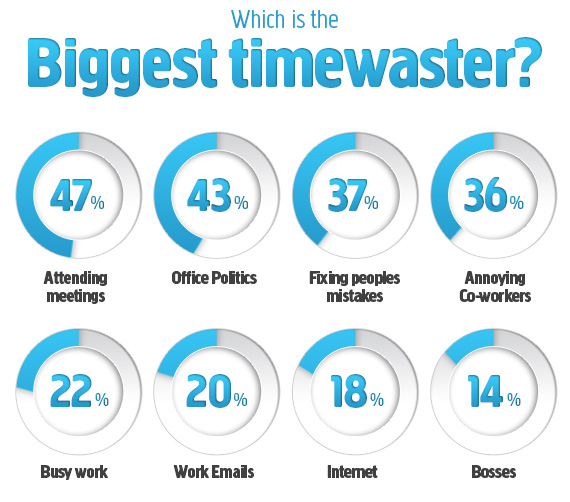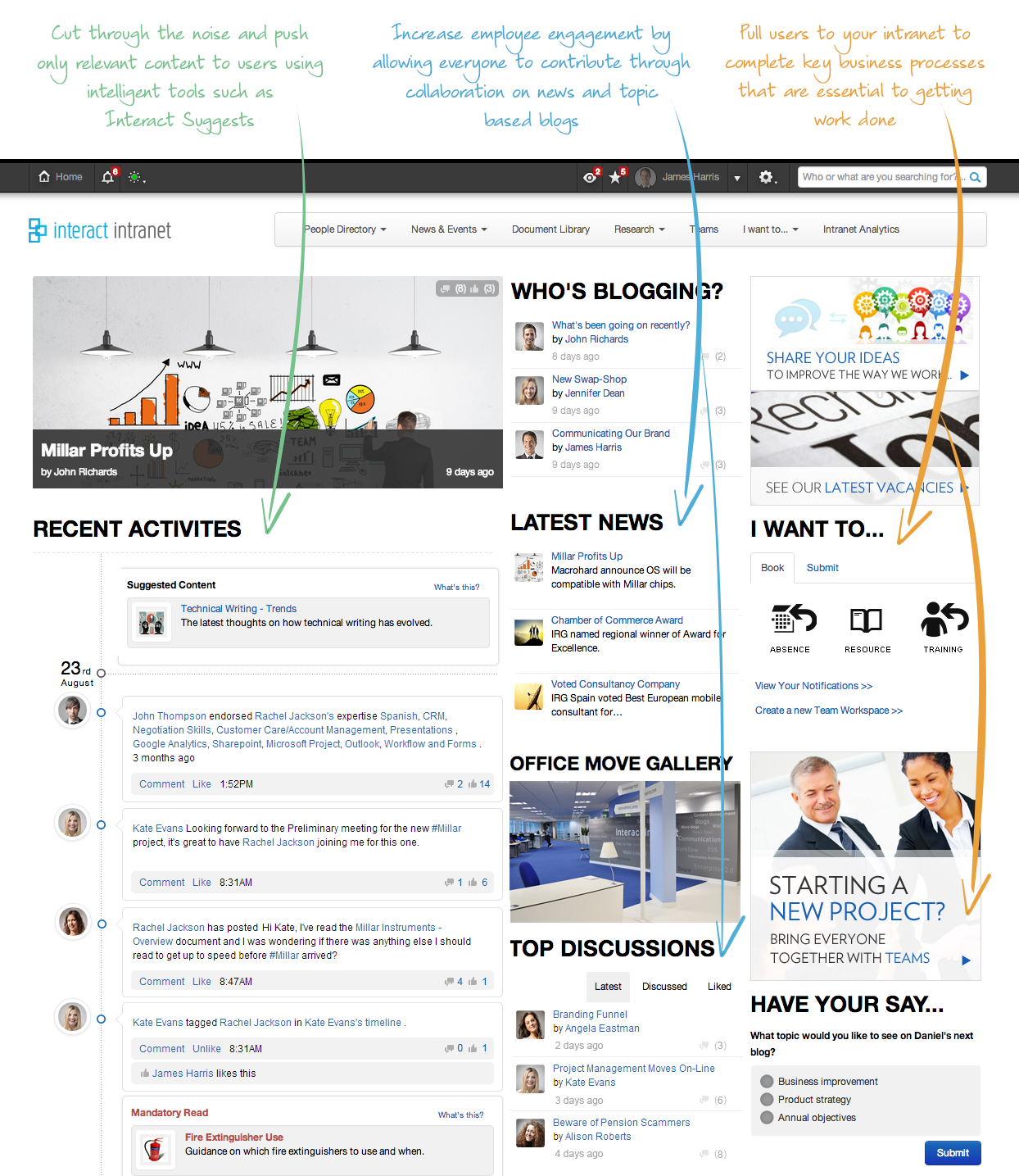4 easy ways to encourage collaboration on your intranet
How many times have you overheard a conversation in your office and taken positive action as a result? Imagine accessing all the conversations in your organisation and filtering the ones relevant to you. Consider the time saved and the reduction in duplicated effort that would bring.
An intranet can maintain a good company culture built on information exchange and collaboration – this is the crux of a social intranet.
Intranets make it easier to move information within an organisation. Departments that once rarely interacted can now collaborate on big projects. The cost of winning and maintaining good client relationships will decrease, while sales and bottom line profits increase. The open communication it fosters reduces the chance of identical projects happening due to lack of communication and transparency; as well as allowing your employees to feel valued and begin to engage more with your objectives. We can identify this shift in two forms:
Here are our key 4 business considerations when encouraging collaboration and how our customers have approached them. (You can also download another 12!)
1. Trust your employees to work together productively, not time-waste
The major commitment to achieving these levels of increased productivity is not cost but trust – the biggest fear we hear from many businesses is that employees will waste time. This organisational challenge is as old as time but choosing not to empower your employees on the back of this is a flawed choice. There’s a major misapprehension that inefficiencies are occurring due to people busing their internet access rights and therefore implementing these tools within the enterprise will exacerbate this issue. Salary.com’s Wasting Time at Work 2012 Report uncovered:

“Only 18% of those surveyed listed the Internet as a time-waster. The biggest waste of time, according to 47% of our respondents, is having to attend too many meetings. That’s followed by dealing with office politics (43%), fixing other peoples’ mistakes (37%), coping with annoying co-workers (36%), busy work (22%) and returning an abundance of work emails (20%). Dealing with bosses came in last
at a mere 14%.”
There are a number of issues here, which trusting your employees to work collaboratively will solve:
- The networks formed between colleagues on your intranet will be apolitical; they are need based rather than hierarchy based
- With the prevalence of the right person being identified by your intranet to do the task first time, people’s mistakes are massively reduced
- If someone annoys you on your intranet, you can easily ignore them
- We would expect your email usage to drop dramatically. Whilst an email is exclusive and largely irretrievable outside of the senders and receivers, when this conversation happens on an intranet that solution is searchable saving the person asking the question time finding a solution and often saving the solution providers time not having to frequently answer the same questions
The vast majority of employees tend to want to be more efficient and want to contribute. Those working in a cascaded communications culture will often feel less engaged. Enable your employees to maximise their productivity by trusting and then enabling them to create and then maximise their networks, all based on need, not location or department. This is a major step to beginning to achieve your potential 25% increased productivity.
Success Story: Wendy Jordan, Glasgow Housing Association
Europe’s largest housing association, Glasgow Housing Association, trusted their employees to be a large part of their success during their change programme. One blog by a front line worker attracted 1,330 employees from a possible 1,360 to read, learn and engage with their change programme – one unprompted blog from someone beyond your traditional influencers influenced a whole organisation’s attitude far more than any cascaded communication could ever achieve.
2. Not everybody needs to be a content author to make collaboration happen
People do not have to be producing content to encourage a collaborative behaviour. Whilst most businesses naturally focus on content authors there are many other important roles which are more suitable for other personality types. Answering “What is in it for me?” for them will see collaborative behaviours happen far more quickly and effectively. Look at who can pass the message out there, who can ensure the quality of links etc. and who can uncover those who look to hoard knowledge rather than sharing it.
Success story: Genevieve Potter, Bauer Media
Genevieve attended Interaction Intranet Conference in 2012 and watched Steve Osborne, one of our leading intranet strategists, present on turning your company’s squirrels (people who hide information for themselves) and turning them into elephants (an elephant never forgets but chooses to lead others to pools of knowledge). She defined three personas she wanted from Bauer Media’s employees on the intranet:
- Knowledge Finders – people hunting out those identified above and winning them over to become elephants. The selling point was explaining to those hoarding knowledge that the intranet wasn’t looking to replace them but make their time more effective by:
a. frequently asked, simple questions being on the intranet so people can quickly find
information, whilst the squirrel doesn’t lose ten minutes a day answering repeated questions
b. making them more visible, ensuring they are prominent when a project needing their
skills arises
- Broadcasters – those who like and share content, using their networks to reach people who may not typically read a certain type of content
- Auditors – might typically be described as pedants. Whilst this is often seen as a negative characteristic, they highlight spelling mistakes, broken links etc. which will save your Intranet Team time in auditing.
3. Show language and time zones are not a barrier
Language and time zones have often been cited as the reason a project can’t get its best people together. It’s the reason we often see a project happening within one country or created around a common language.
Martin White of Intranet Focus identifies in his work on Getting the Best From Virtual Teams that 57% of people in virtual teams feared the primary challenge in managing a virtual team would be “misunderstandings due to differences in culture, language, inability to read people’s expressions etc.” However, Martin also identifies that with an effective team protocol this can easily be overcome – identifying common terms and creating best usage guidance.
You might have a corporate language but if you don’t the Interact Translator widget will ease a number of traditional language issues. With these virtual teams you aren’t creating an Instant Messaging solution, you’re creating an area to share problems, solutions and agree good practice, driven by the challenge, not by the variables such as time, proximity or language.
Success story: Anna Downie, International HIV / AIDS Alliance
Global charity, International HIV / AIDS Alliance, recently launched a number of new social tools on their intranet and within the first few hours Senegal started to blog about their work on preventative measures to curb the spread of AIDS through intravenous drug use. Unbeknown to them, Cambodia was conducting a similar programme.
The Cambodian AIDS Alliance started to respond to the blog in their own language using comments and now both are working in partnership to combat the spread of AIDS through intravenous drug use.
4. Understand your range of tools and form your own perfect blend
Interact have discussed at length the idea of creating a perfect blend – finding a balance between communication, business processes and collaborative tools which creates a blend of tools, to make your intranet essential to your company. Companies will vary in how advanced each of these key criteria are and the appetite that company has to maximise their effectiveness.
It is imperative you understand how your company currently operates and what you want to achieve. Once you have done this you can break that end goal down into a number of achievable steps. Remember creating a collaborative culture occurs over a number of phases, not a straight switch to say “today we are going to go social”.
One way to solve this is to display your content and homepages in logical streams, as shown on the following page:

Success story: Mark Entwistle (Romec), Malcolm Payne (American Golf) & Paula Kenyon (Dollar Finance)
Facilities management company Romec, save GBP2 million per year with traditional electronic forms for essential business processes. Waterstones, Dollar Finance and American Golf use their intranets for critical communications between head office and stores. In all three cases collaborative tools such as team areas and discussion forums are heavily used for two-way communication that supplement and enhance business processes.
